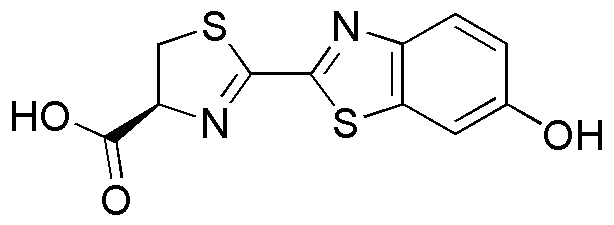D-Luciferin is widely utilized in research focused on:
- Bioluminescence Imaging: This compound is essential for in vivo imaging in biological research, allowing scientists to visualize cellular processes in real-time using light emitted from D-Luciferin when it reacts with luciferase enzymes.
- Drug Development: In pharmacology, D-Luciferin is used to monitor the efficacy of drug candidates by tracking cellular responses and metabolic activities, providing insights into drug mechanisms and effects.
- Gene Expression Studies: Researchers employ D-Luciferin in reporter assays to study gene expression, enabling the assessment of promoter activity and the effects of regulatory elements in various biological contexts.
- Environmental Monitoring: This compound is used in ecotoxicology to assess the impact of pollutants on living organisms, helping researchers understand the effects of environmental stressors on bioluminescent species.
- Pathogen Detection: D-Luciferin is utilized in assays for detecting pathogens, such as bacteria and viruses, by providing a sensitive and rapid method for identifying infectious agents in clinical and environmental samples.
Informations générales
Propriétés
Sécurité et réglementation
Applications
D-Luciferin is widely utilized in research focused on:
- Bioluminescence Imaging: This compound is essential for in vivo imaging in biological research, allowing scientists to visualize cellular processes in real-time using light emitted from D-Luciferin when it reacts with luciferase enzymes.
- Drug Development: In pharmacology, D-Luciferin is used to monitor the efficacy of drug candidates by tracking cellular responses and metabolic activities, providing insights into drug mechanisms and effects.
- Gene Expression Studies: Researchers employ D-Luciferin in reporter assays to study gene expression, enabling the assessment of promoter activity and the effects of regulatory elements in various biological contexts.
- Environmental Monitoring: This compound is used in ecotoxicology to assess the impact of pollutants on living organisms, helping researchers understand the effects of environmental stressors on bioluminescent species.
- Pathogen Detection: D-Luciferin is utilized in assays for detecting pathogens, such as bacteria and viruses, by providing a sensitive and rapid method for identifying infectious agents in clinical and environmental samples.
Documents
Fiches de données de sécurité (FDS)
La FDS fournit des informations de sécurité complètes sur la manipulation, le stockage et l’élimination du produit.
Spécifications du produit (PS)
Le PS fournit une description complète des propriétés du produit, notamment sa composition chimique, son état physique, sa pureté et les exigences de stockage. Il détaille également les plages de qualité acceptables et les applications prévues du produit.
Certificats d'analyse (COA)
Recherchez des certificats d'analyse (COA) en saisissant le numéro de lot du produit. Les numéros de lot et de lot se trouvent sur l'étiquette d'un produit, après les mots « Lot » ou « Lot de fabrication ».
Numéro de catalogue
Numéro de lot/série
Certificats d'origine (COO)
Ce certificat d'exploitation confirme le pays dans lequel le produit a été fabriqué, et détaille également les matériaux et composants utilisés et s'il est issu de sources naturelles, synthétiques ou autres sources spécifiques. Ce certificat peut être requis pour les douanes, le commerce et la conformité réglementaire.
Numéro de catalogue
Numéro de lot/série
Fiches de données de sécurité (FDS)
La FDS fournit des informations de sécurité complètes sur la manipulation, le stockage et l’élimination du produit.
DownloadSpécifications du produit (PS)
Le PS fournit une description complète des propriétés du produit, notamment sa composition chimique, son état physique, sa pureté et les exigences de stockage. Il détaille également les plages de qualité acceptables et les applications prévues du produit.
DownloadCertificats d'analyse (COA)
Recherchez des certificats d'analyse (COA) en saisissant le numéro de lot du produit. Les numéros de lot et de lot se trouvent sur l'étiquette d'un produit, après les mots « Lot » ou « Lot de fabrication ».
Numéro de catalogue
Numéro de lot/série
Certificats d'origine (COO)
Ce certificat d'exploitation confirme le pays dans lequel le produit a été fabriqué, et détaille également les matériaux et composants utilisés et s'il est issu de sources naturelles, synthétiques ou autres sources spécifiques. Ce certificat peut être requis pour les douanes, le commerce et la conformité réglementaire.

